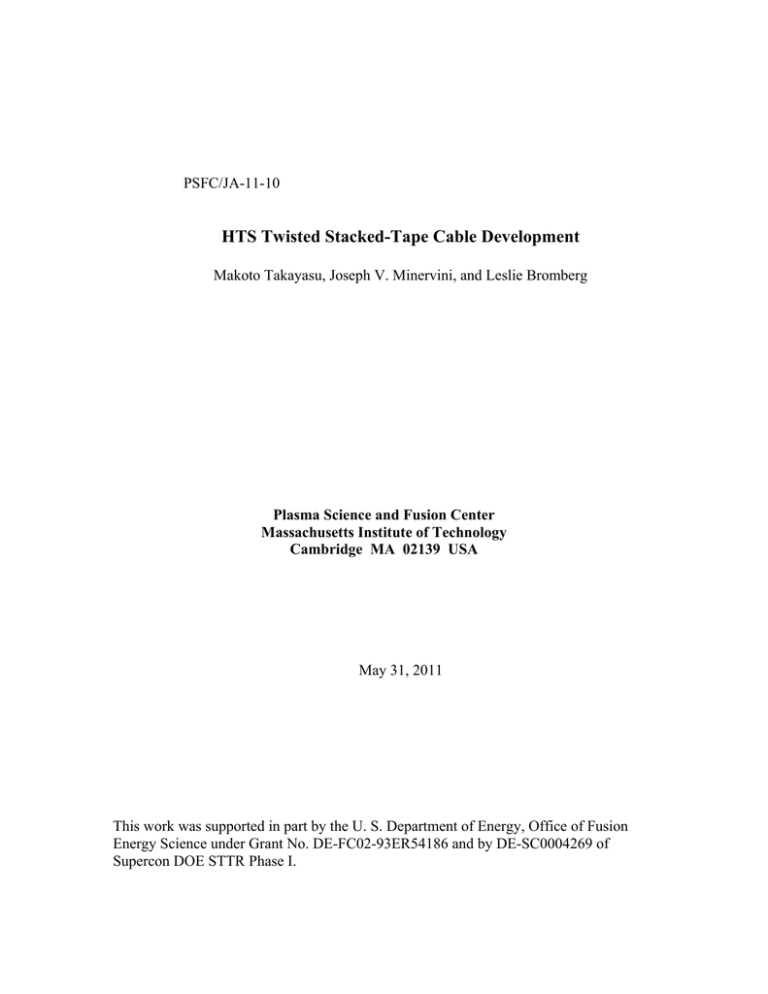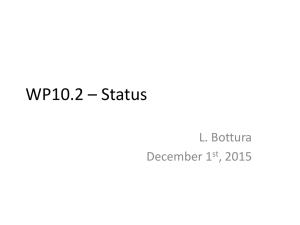HTS Twisted Stacked-Tape Cable Development
advertisement

PSFC/JA-11-10 HTS Twisted Stacked-Tape Cable Development Makoto Takayasu, Joseph V. Minervini, and Leslie Bromberg Plasma Science and Fusion Center Massachusetts Institute of Technology Cambridge MA 02139 USA May 31, 2011 This work was supported in part by the U. S. Department of Energy, Office of Fusion Energy Science under Grant No. DE-FC02-93ER54186 and by DE-SC0004269 of Supercon DOE STTR Phase I. ABSTRACT Key issues for a twisted stacked-tape cabling concept have been investigated. The issues include: a) tape twisting performance; b) twisted-cable bending performance; c) development of a feasible manufacturing method; and d) YBCO cable termination method. A fabrication method for a twisted stacked tape conductor of 4 mm YBCO tapes has been developed and tested. A 2 m long, 32-YBCO-tape conductor with a 200 mm twist pitch was fabricated. The measured critical current of the straight cable was 1.53 kA which agrees with the expected values estimated from the self-field. The same cable wound on a surface of a 0.5 m diameter disk did not show any degradations. It has been confirmed through tests with single tape and cable tests that it is possible to develop a HTS stacked cable with a 200 mm twist pitch. This cable could be used to make a coil with an innermost turn of at least 0.5 m diameter. A joint method for a multi-tape YBCO cable has been developed and operated at 2.2 kA. The twisted stacked-tape cabling method for YBCO tapes will be very useful for high-current high-field magnets for various applications. KEYWORDS: Tape cabling, twisted stacked tape cable, critical current, high temperature superconductor, and YBCO tape joint. 2 Contents 1. Introduction 2. Evaluations of YBCO AP single tape 3. Bending tests of twisted stacked-tape cable 4. Termination method 5. Cable tests of 2 m long twisted stacked-tape conductor 6. Examinations of Fabrication method of twisted stacked-tape cabling conductor 6.1 One spiral groove in a copper rod 6.2 Three spiral grooves in a copper rod 6.3 An industrial cabling method 7. Discussion and Conclusions Acknowledgement References 3 1. Introduction High current superconducting conductor enables the manufacture of high field, large scale magnets. Fusion magnets, with large stored energy, need high current for fast ramp rate (as OH solenoids, for example), or for protection of quick energy dump. The goal is to develop 10 kA-class cables. In addition, joints of high current conductors are difficult because of the asymmetric nature of the HTS YBCO tapes due to the electrically insulating buffer layers between the substrate and the superconductor. We have previously summarized a twisted stacked-tape cabling method for high temperature superconducting (HTS) tapes [1]. In this report we discuss recent cable test results for YBCO tapes, including cable bending tests and a termination method developed with BSCCO tapes for YBCO tape cables. In section 2, we evaluate the performance of single twisted tapes. In Section 3, the behavior under bending of stacks of HTS tapes are investigated. Section 4 described the novel method of joining YBCO tapes. Section 5 describes tests carried out on a 2 m long section of twisted stacked tape cable. Section 6 describes fabrication methods that can be scaled up to long lengths. Finally, section 7 summarizes the work. 2. Evaluations of YBCO AP single tape In order to understand the performance of twisted stacked-tape cables, tests on single tapes were carried out. YBCO Advanced Pinned Zr-doped tapes from SuperPower Inc. were used in the tests. Tapes were tested in parallel (B//ab) and perpendicular (B//c) fields up to 1.5 T at 77 K. The critical current and the n-index of the tapes, at 77 K, are shown in Fig. 1. The critical current dependences upon field orientation, shown in Fig. 2, were measured at various magnetic fields between 0.1 T and 1.0 T. . (a) (b) Fig. 1 Critical current behaviors of SuperPower Inc. YBCO Advanced Pinned tape in parallel (B//ab) and perpendicular (B//c) fields at 77 K. (a) Critical current and (b) nindex values as a function of magnetic field. 4 The critical currents in perpendicular field were larger than those in parallel field at 77 K. This characteristic has been observed by SuperPower Zr-doped YBCO tapes [2]. The ratio of the critical currents in perpendicular field to that in parallel field can be controlled with Zr doping technology of SuperPower. For twisted stacked-tape conductor the perpendicular self-field to the stacked tapes is substantial due to tightly packed nature of the high-density conductor. Because of the improved performance of the SuperPower tapes to fields normal to the tapes, the presence of strong perpendicular fields in the twisted stack cable will not be a negative factor any more. Furthermore, field orientation dependences of YBCO have improved further recently [2]. Fig. 2 Field orientation effect of the critical currents at various magnetic fields between 0.1 T and 1.0 T at 77 K. 3. Bending tests of twisted stacked-tape cable Twisting and bending tests of a short twisted stacked-tape cable were performed using a 17” (432 mm) length cable made from 4 YBCO tapes and 20 YBCO dummy tapes (low performance tapes). The 4 mm YBCO tape stacked cable were mounted between copper strips (4.8 mm wide and 0.82 mm thick) at the bottom and top as shown in Fig. 3. Four YBCO tapes were embedded in the tape stack at the locations #3, #10, #15 and #22 from the top. The 4 tested YBCO tapes were electrically insulated with 68 µm Kapton tape placed between the dummy tapes adjacent to the tested tapes and the YBCO tapes. The critical currents in each of the four tapes among 24 were measured. The critical current of each tested tape was measured prior to twisting the cable. The cable was then twisted with a twist pitch of 200 mm [3], followed by bending tests. Various bending radius were used to investigate the dependence of the critical currents under bending. The tests were carried out at 77 K, and the bending radii used were 600 mm, 400 mm and 200 mm. Figs. 4 and 5 show photographs for the cable bent with 400 mm radius and 200 mm radius, respectively. The results obtained for the four tapes were plotted in Fig. 6. The results indicated no degradation of performance of the cable with twist pitches as short as 200 mm and bending radius as small as 200 mm. 5 Fig. 3 Stacked YBCO tape cable prior to twisting. A total of 24 YBCO tapes (including 20 dummy tapes) of 4 mm width are mounted between 2 copper strips of 4.8 mm width and 0.82 mm thickness at the bottom and top. The 4 tested tapes were electrically insulated with Kapton tape. Fig. 4 Twisted stacked-tape cable mounted on a bent fixture of the radius 400 mm. Fig. 5 Tested twisted stacked-tape cable with a bent fixture of the radius 200 mm in liquid nitrogen. From these short cable results, we concluded that a twisted stacked-tape conductor could be fabricated with a twist pitch of 200 mm and the bending radius of 200 mm. 6 Further optimization will be performed latter. Sheathed conductors and soldering effects will be investigated, and twist pitch and the bending radius will be optimized. (a) (b) Fig. 6 Bending tests of the critical currents for a 17” (432 mm) 24 YBCO stacked tape cable. After testing the untwisted cable, the cable was twisted with a twist pitch of 200 mm. Then the twisted cable was wound around spools of radii of 600 mm, 400 mm and 200 mm sequentially, and measured the critical currents at 77 K. (a) Critical current, (b) n-index values. 4. Termination method 7 When YBCO tapes are stacked for a multi-tape conductor, the conductor terminations and joints between the tapes must be fabricated properly taking into account of the asymmetric electric conductivity [4]. A termination method for a YBCO tape cable has been developed that uses symmetric HTS tapes such as BSCCO tapes as shown in Fig. 7. This figure illustrates a stacked YBCO tape cables (right side) composed of multiple tape cables to be terminated to a copper lead (not shown). The conductive side (silver layer side) of each tape of the stacked YBCO cable is connected to a BSCCO tape. The opposite end of the BSCCO tapes is soldered to a copper lead. Additional BSCCO tapes, if required, are inserted between the BSCCO tapes to obtain a uniform height and match the height required to insert the YBCO tapes between BSCCO tapes at the joint section. In the YBCO/BSCCO joint section, YBCO tapes (conductive silver side) are soldered to BSCCO tape to make low resistive connection for a permanent joint, or they are jointed with mechanical pressure contacts without soldering for a demountable joint. A termination for YBCO tape cable is shown in Fig. 8 based on the method described above. The soldered termination section in Fig. 7 is encapsulated in a metallic tube of good electric conductive material such as copper, as shown in Figure 8. Fig. 7 Conceptual schematic illustration of proposed YBCO Tape termination using BSCCO tapes between YBCO tapes and copper joint. 8 Fig. 8 YBCO tapes are sandwiched between BSCCO tapes of a compact termination unit. Fig. 9 shows pictures of a fabricated copper-BSCCO-YBCO terminations. Fig. 9(a) shows a small termination made of 7.9 mm diameter, 100 mm length copper tube with eleven 4 mm BSCCO tapes each 250 mm long. The 11 BSCCO tapes were stacked and inserted into the copper tube. 100 mm of 250 mm BSCCO tapes were soldered in the copper tube. The remaining 150 mm length of the BSCCO tapes were used for joints to the YBCO tapes. The YBCO tapes were sandwiched between the BSCCO tapes one at a time, and then the stacked tape assembly was clamped with 70 mm length G10 plate without solder, and bolted with an applied pressure of about 50 MPa, as shown in Fig. 9(b). In this test each termination between YBCO and BSCCO tapes was insulated from each other in order to measure each termination resistance separately. The termination resistance of each contact joint was measured by voltage taps made of insulated thin copper tapes seen in Fig. 9(b). Measured contact joint resistances between YBCO and BSCCO tapes were 1.07 ± 0.18 µΩ at 77 K. Fig. 9(c) shows a YBCO cable termination used for a stacked tape cable made from 43 YBCO tapes. The termination consisted of 44 BSCCO tapes (4 mm width, 220 mm length) with a 19.1 mm diameter copper tube of 100 mm length. 100 mm of the BSCCO tapes were soldered together inside a copper tube. The copper tube was clamped to a copper block, shown in Fig. 9(d), without soldering to connect to a copper power cable. The stacked YBCO tapes were sandwiched between the BSCCO tapes, and then the solder-free stacked tape assembly was clamped with 70 mm length G10 plate and bolted. Joint resistances of between YBCO and BSCCO tapes were measured for ten YBCO tapes among 43 tapes one at a time with a current of up to 50 A in liquid nitrogen. The results are shown in Fig. 10. The contact joint resistances decreased with the contact pressures. At 55 MPa the measured resistances were about 1 µΩ. The standard deviations of the measured resistances obtained for ten samples were also decreased with the applied pressure, as shown in Fig. 10. The resistance between the copper tube and the 9 copper block was about 0.5 µΩ including copper resistances. The 44 BSCCO tape terminators have been operated at up to 2.2 kA. This method can be used for a termination of a stacked tape cable, and also for a joint between stacked tape cables. The termination and joint methods allow design flexibilities of joint fabrications either for a permanent soldered joint or a demountable joint. Furthermore by using higher Tc HTS tapes such as BSCCO tapes, degradations of YBCO conductors due to temperature rise at joint area can be reduced. (b) (a) (d) (c) Fig. 9 Fabricated BSCCO tape terminators for a YBCO tape cable. (a) Eleven BSCCO tapes of 250 mm length soldered in a 7.9 mm diameter, 100 mm length copper tube. (b) Pressure contact joints between YBCO and BSCCO tapes, clamped with 70 mm length G10 plats and bolts. (c) 44 BSCCO tape terminator (left) for a 43 stacked-tape YBCO conductor (right). Stacked YBCO tapes were sandwiched between the BSCCO tapes (center) which were clamped with 70 mm length G10 plate without soldering. The BSCCO tapes were soldered in a copper tube (left). (d) The copper tube was cramped on a copper block to connect to a copper power cable. 10 Fig. 10 Pressure contact joint resistances between YBCO and BSCCO tapes as a function of the contact pressure, measured for 70 mm length terminator. Standard deviations of the resistances obtained for ten samples are also shown. 5. Cable tests of 2 m long twisted stacked-tape conductor An 84” (2.13 m) cable was fabricated by the same technique used for the bending test cable described above. The length includes joint sections of about 6” (150 mm) at each end. In this long cable test, 32 YBCO tapes were stacked with two copper strips (0.82 mm thickness and 4.8 mm width). The stacked tape conductor cross-section was approximately a square shape of 4.8 mm x 4.8 mm. The cable was twisted with a twist pitch of 200 mm. A section of the 2 m length conductor is shown in Fig. 11. Fig. 11 A section of 2 m length, 32 tapes, YBCO stacked-tape cable twisted with a twist pitch of 200 mm. 11 Fig. 12 2 m sample in a nitrogen container. The straight cable was tested in liquid nitrogen in self-field (as shown in Fig. 12). The V-I curve obtained at 77 K is shown in Fig, 13. The critical current at the criterion Ec=100 micro-V/m was 1.53 kA with an n-index value of 24.1. The critical currents of SuperPower YBCO tapes used for the cable fabrication were about 85 A at 77 K. Therefore the critical current degradation was about 44%. It can be explained by the selffield effect of the conductor [5]. This result indicates that the YBCO tapes did not degrade by the fabrication method. 12 Fig. 13 V-I curve measured for MIT 2 m straight twisted stacked-tape cable of 32 YBCO tapes. In order to examine a feasibility of winding capability of the twisted stacked-tape HTS conductor, the 2 m cable was mounted along the circumference of a 0.5 m diameter spool to form one turn coil as shown in Fig. 14, and tested in liquid nitrogen. The test result (the V-I curve was very similar to Fig. 13) of the critical current of 1.54 kA with n=23.7 showed no degradation due to bending of 0.5 m diameter. This result agrees with the bending tests of the short conductor described above. Fig. 14 One turn coil of MIT 2 m twisted stacked-tape cable mounted on a side surface of a 0.5 m diameter disk. 6. Examinations of Fabrication method of twisted stacked-tape cabling conductor We tested a fabrication method of twisted stacked-tape conductor that used a helical groove on a copper rod. The sheath fabrication technique was demonstrated in short 13 lengths using a four-axial CNC Milling machine. The sheaths were fabricated at MIT. It has been also fabricated in the same machining to make three helical grooves on a rod. In this method, the stacked tapes would be embedded into the helical grooves to make a basic round conductor that contains one or multiple twisted stacked-tape cables. A stacked tape conductor or a “twisted” stacked-tape cable can be embedded in each groove. The latter conductor can provide a lower coupling loss cable having a shorter twist pitch. 6.1 One spiral groove in a copper rod Fig. 15(a) shows one helical groove machined on a copper rod of a 3/8” (9.53 mm) diameter (groove pitch 6” (152.4 mm), depth 6.48 mm, width 4.32 mm). In the helical channel, a cable stacked with 40 YBCO tapes can be embedded. Fig. 15(b) shows a Cable-in-Conduit Conductor (CICC) composed of a twisted stacked cable on a 9.53 mm diameter copper rod in a 12 mm x 12 mm conduit. (a) (b) Fig. 15 (a) One spiral groove in one rod: A copper rod with one helical channel. Copper rod 3/8” (9.53 mm) diameter, groove pitch 6” (152.4 mm), depth 6.48 mm, width 4.32 mm. 40 YBCO tapes can be stacked in the groove. (b) 12 mm x 12 mm CICC of a twisted stacked cable. 6.2 Three spiral grooves in a copper rod Three helical grooves in a rod were machined on a copper rod of 3/8” (9.53 mm) diameter (groove pitch 10” (254 mm), depth 2.92 mm, width 4.32 mm) is shown in Fig. 16(a). Fig. 16(b) shows three helical groove CICC of 20-YBCO-tapes in each groove. Total 60 tapes were embedded in the CICC. (a) (b) Fig. 16 (a) Three helical grooves in a rod 3/8” (9.53 mm) diameter, groove pitch 10” (254 mm), depth 2.92 mm, width 4.32 mm. (b) Three helical channel CICC composed of 20-YBCO-tape cable in each groove in a copper diameter 9.53 mm (Total 60 YBCO tapes). 14 6.3 An industrial cabling method A mass-production method for a former with helical channels made through extrusion can be developed. A twisted stacked-tape cabling using a rod type former with helical grooves will be produced in an industrial scale by a machine shown in Fig. 17. Fig. 17 A continuous cable manufacturing process with a single twisted stacked-tape 7. Discussion and Conclusions A fabrication method for a twisted stacked tape conductor of 4 mm YBCO tapes has been developed and tested. A 2 m long, 32-YBCO-tape twisted stacked conductor with 200 mm twist pitch was fabricated. The critical current of the cable was 1.53 kA at 77 K which agreed with the expected values estimated from the self-field. It indicated that the YBCO tapes did not degrade by the fabrication method. The same cable wound on a surface of a 0.5 m diameter disk resulted the same critical current. It has been confirmed that it is possible to develop a HTS stacked cable with a 200 mm twist pitch and make a coil of an innermost turn of at least 0.5 m diameter. A joint fabrication method for YBCO tapes has been developed. YBCO tapes have asymmetric conductivity since the conductivity from one side of the YBCO tape is different from that of the other side, due to the internal insulating buffer layers between 15 the superconducting film and the substrate. A termination method using copper and BSCCO tapes for YBCO cables was developed. In this method the YBCO tapes were terminated through the BSCCO tapes. The connection between the opposite ends of the BSCCO tapes were soldered to copper. The joint resistance of a solder-free contact between YBCO and BSCCO tapes was below 1 µΩ per tape joint at the contact pressure of about 55 MPa. The mechanical contact joint method is of particular interest because it can be used for demountable joints. The 44 BSCCO tape terminators without soldering have been operated at up to 2.2 kA. A stacked and twisted conductor of 7 mm diameter composed of the 40 tapes may carry up to approximately 1.5 kA at 77 K with self field and 4.5 kA at 15 T and 4.2 K. A three-stage 9-conductor cable (3x3) of 32 mm diameter may provide 15 kA at 77 K at self-field and 40 kA at 15 T and 4.2 K. For the same conductor diameter, it may be possible to make a 12-conductor cable with a single stage cabling of 20 kA at 77 K at self field and 50 kA at 4.2 K and 15 T. Acknowledgement This work was supported in part by the U. S. Department of Energy, Office of Fusion Energy Science under Grant No. DE-FC02-93ER54186 and by DE-SC0004269 of Supercon DOE STTR Phase I. The authors would like to thank Andre Berger and Franco J. Mangiarotti, PSFC, MIT for helping experiments. References 1. M. Takayasu, L. Chiesa, L. Bromberg, and J.V. Minervini, “Investigation of HTS Twisted Stacked-Tape conductor,” MIT PSFC report, PSFC/JA-11-4, March 2011. 2. V. Selvamanickam, et al., “Progress in SuperPower’s 2G HTS wire development and manufacturing,” presented at the 2010 DOE Advanced Cables & Conductors Peer Review, Alexandria, VA, June 29, 2010. 3. M. Takayasu, J.V. Minervini, and, L. Bromberg, “Torsion Strain Effects on Critical Currents of HTS Superconducting Tapes,” Adv. Cryo. Eng., 56, Plenum, N.Y., 337344, 2008. 4. M. Takayasu, “Superconducting Tape cable Termination,” US provisional patent application No. 61/400,858, 2010. 5. M. Takayasu, L. Chiesa, L. Bromberg, and J.V. Minervini, “Cabling Method for High Current Conductors Made of HTS Tapes,” presented at the 2010 Applied Superconductivity Conference, Washington D. C., August 2010. 16




